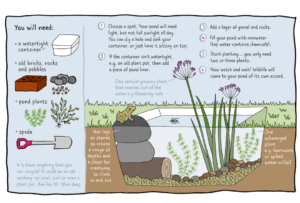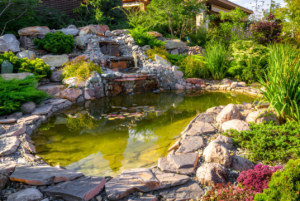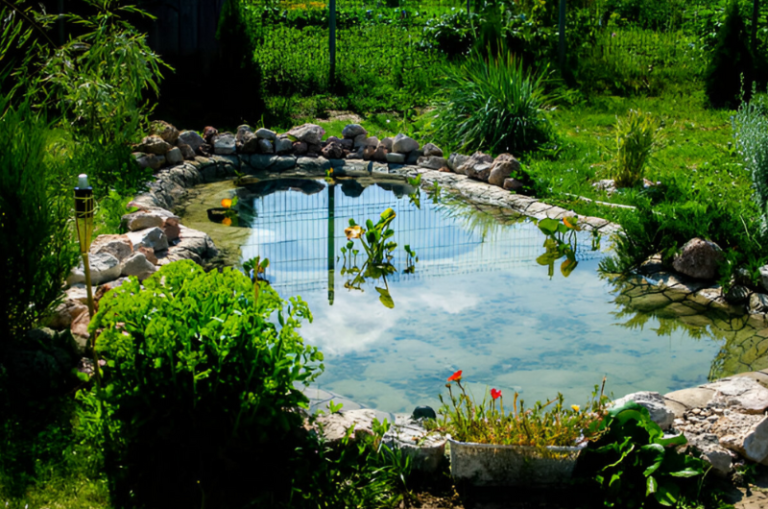Creating a mini pond in your garden is a fantastic way to enhance your outdoor space. Whether your goal is to attract wildlife, add visual appeal, or create a peaceful retreat, learning how to make a mini pond in your garden is both simple and rewarding. This guide will walk you through the entire process to ensure your garden pond becomes a thriving mini-ecosystem.

Benefits of Adding a Mini Pond
- Encourages wildlife: Frogs, birds, and insects will find refuge in your pond.
- Eco-friendly pest control: Fish or frogs help keep mosquito larvae at bay.
- Enhances aesthetics: A pond brings a serene and visually attractive focal point to your garden.
- Ideal for small spaces: Even if you don’t have much room, learning how to make a mini pond in your garden ensures you can enjoy a water feature, no matter the size of your outdoor space.
For tips on encouraging local wildlife and choosing the right aquatic plants, visit the National Wildlife Federation and RHS for more expert advice.
Step 1: Choosing the Best Location
Selecting the right location is key to building a successful pond. Here are important considerations:
- Sunlight: Aim for partial sunlight—half a day of sun is ideal to prevent overheating.
- Avoid runoff areas: Prevent fertilizers or chemicals from entering the pond.
- Safety considerations: If pets or children are nearby, place the pond on a raised platform or use barriers for protection.
Additionally, consider planting flowering plants that bloom year-round to complement your pond. You can learn more from our guide on flowering plants for winter.
Step 2: Selecting the Right Container or Pond Liner
Choosing the right container will define the aesthetics and function of your pond. Here are a few options:
- Upcycled containers: Use old barrels, ceramic pots, or basins.
- Waterproof options: Metal and ceramic containers are durable in extreme weather.
- Using pond liners: For a custom shape, dig a shallow hole and line it with a pond liner.
Pro Tip: Ensure the container is at least 2 feet in diameter to accommodate both plants and small animals.
Step 3: Materials and Tools Checklist
You’ll need the following items to build your pond:
- Waterproof container or liner
- Gravel and stones
- Aquatic plants (water lilies, cattails)
- Rainwater or treated tap water
- Optional: Pumps, filters, or solar-powered fountains
Step 4: Designing and Excavating the Pond

If you are creating a custom in-ground pond, follow these steps:
- Vary depths: Make a shallow edge for plants (10-12 inches) and a deeper center for fish (2 feet).
- Shape matters: Avoid perfect circles to give your pond a natural look.
- Add sand: Place sand beneath the liner to protect against sharp rocks.
Step 5: Adding Decorative and Functional Elements
Once your pond is dug and lined, it’s time to add:
- Gravel: This anchors plants and prevents soil erosion.
- Stones and logs: Use these to create natural hiding places for wildlife.
- Steps: Add steps for safe entry and exit for small animals.
Step 6: Filling the Pond with Water
For best results:
- Use rainwater: It’s chemical-free and supports wildlife.
- Neutralize tap water: Let tap water sit for 48 hours to remove chlorine before adding plants or animals.
Step 7: Planting Aquatic Plants
Adding plants ensures your mini pond becomes a thriving ecosystem. Consider these plant types:
- Submerged plants: Anacharis for oxygenating water
- Floating plants: Water lettuce to provide shade
- Marginal plants: Cattails and marsh marigolds along the pond edges
Place plants in mesh containers to prevent root spreading and use aquatic compost for healthy growth.
Step 8: Encouraging Wildlife
Your pond will naturally attract wildlife, but you can enhance this by:
- Letting frogs find the pond naturally: Avoid relocating them from other areas.
- Adding fish: Fish help manage mosquito larvae but require a filter.
- Creating shaded areas: Add floating plants to provide cover from predators.
Optional: Install Pumps, Filters, and Lights
Pumps, filters, and lights enhance both the functionality and appearance of your pond:
- Filters and pumps: These keep water clear and oxygenated.
- Solar-powered fountains: Add visual appeal while providing aeration.
- Garden lights: Solar lights highlight the pond during evenings.
Maintenance Tips for Every Season
Proper maintenance ensures your pond remains clean and healthy:
- Remove debris: Scoop out leaves to prevent algae buildup.
- Winter care: Bring fish indoors or use pond heaters during cold weather.
- Manage algae: Scoop out algae regularly and avoid overfeeding fish.
Learn more about efficient watering techniques by visiting our guide on Chapin bucket irrigation, which can complement your pond ecosystem.
Frequently Asked Questions (FAQs)
How does the pond stay clean?
A filter helps oxygenate the water and keep it clear. Regular water changes also prevent stagnation.
Can I use soil in my pond?
It’s better to use aquatic compost instead of soil, as soil can cloud the water and harm aquatic life.
Will wildlife naturally find the pond?
Yes, frogs, birds, and insects will be attracted to the water and plants over time.
How deep should my pond be?
10-12 inches is ideal for most plants, while fish need a depth of at least 2 feet to thrive.
Conclusion
Building a mini pond is a simple yet rewarding way to enhance your garden. Whether you choose an in-ground pond or a container setup, it offers a beautiful focal point and promotes biodiversity. Regular maintenance and thoughtful design will ensure your pond becomes a thriving mini-ecosystem.
With the right placement, plants, and wildlife, your garden pond can be a sustainable and beautiful feature. For a more comprehensive guide to year-round garden care, don’t miss our tips on winterizing palm trees.
